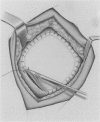Abstract
Most abdominal wall incisional hernias can be repaired by primary closure. However, where the defect is large or there is tension on the closure, the use of a prosthetic material is indicated. Expanded polytetrafluoroethylene (PTFE) patches were used to repair incisional hernias in 28 patients between November 1983 and December 1986. Twelve of these patients (43%) had a prior failure of a primary repair. Reherniation occurred in three patients (10.7%). Wound infections developed in two patients (7.1%), both of whom had existing intestinal stomas, one with an intercurrent pelvic abscess. The prosthetic patch was removed in the patient with the abscess, but the infection was resolved in the other without sequelae. Septic complications did not occur after any operations performed in uncontaminated fields. None of the patients exhibited any undue discomfort, wound pain, erythema, or induration. Complications related to adhesions, erosion of the patch material into the viscera, bowel obstruction, or fistula formation did not occur. Based on this clinical experience, the authors believe that the PTFE patch appears to represent an advance in synthetic abdominal wall substitutes.
Full text
PDF




Images in this article
Selected References
These references are in PubMed. This may not be the complete list of references from this article.
- ADLER R. H. An evaluation of surgical mesh in the repair of hernias and tissue defects. Arch Surg. 1962 Nov;85:836–844. doi: 10.1001/archsurg.1962.01310050138022. [DOI] [PubMed] [Google Scholar]
- Bartlett W. III. An Improved Filigree for the Repair of Large Defects in the Abdominal Wall. Ann Surg. 1903 Jul;38(1):47–62. doi: 10.1097/00000658-190307000-00003. [DOI] [PMC free article] [PubMed] [Google Scholar]
- Bothra R. Late onset small bowel fistula due to tantalum mesh. Am J Surg. 1973 May;125(5):649–650. doi: 10.1016/0002-9610(73)90156-6. [DOI] [PubMed] [Google Scholar]
- Brown G. L., Richardson J. D., Malangoni M. A., Tobin G. R., Ackerman D., Polk H. C., Jr Comparison of prosthetic materials for abdominal wall reconstruction in the presence of contamination and infection. Ann Surg. 1985 Jun;201(6):705–711. doi: 10.1097/00000658-198506000-00006. [DOI] [PMC free article] [PubMed] [Google Scholar]
- Burke G. L. THE CORROSION OF METALS IN TISSUES; AND AN INTRODUCTION TO TANTALUM. Can Med Assoc J. 1940 Aug;43(2):125–128. [PMC free article] [PubMed] [Google Scholar]
- Elliott M. P., Juler G. L. Comparison of Marlex mesh and microporous teflon sheets when used for hernia repair in the experimental animal. Am J Surg. 1979 Mar;137(3):342–344. doi: 10.1016/0002-9610(79)90063-1. [DOI] [PubMed] [Google Scholar]
- GIBSON L. D., STAFFORD C. E. SYNTHETIC MESH REPAIR OF ABDOMINAL WALL DEFECTS: FOLLOW UP AND REAPPRAISAL. Am Surg. 1964 Aug;30:481–486. [PubMed] [Google Scholar]
- HARRISON J. H. A teflon weave for replacing tissue defects. Surg Gynecol Obstet. 1957 May;104(5):584–590. [PubMed] [Google Scholar]
- Hamer-Hodges D. W., Scott N. B. Surgeon's workshop. Replacement of an abdominal wall defect using expanded PTFE sheet (Gore-tex). J R Coll Surg Edinb. 1985 Feb;30(1):65–67. [PubMed] [Google Scholar]
- Kaufman Z., Engelberg M., Zager M. Fecal fistula: a late complication of Marlex mesh repair. Dis Colon Rectum. 1981 Oct;24(7):543–544. doi: 10.1007/BF02604320. [DOI] [PubMed] [Google Scholar]
- Koontz A. R. Preliminary Report on the Use of Tantalum Mesh in the Repair of Ventral Hernias. Ann Surg. 1948 May;127(5):1079–1085. doi: 10.1097/00000658-194805000-00026. [DOI] [PMC free article] [PubMed] [Google Scholar]
- Lamb J. P., Vitale T., Kaminski D. L. Comparative evaluation of synthetic meshes used for abdominal wall replacement. Surgery. 1983 May;93(5):643–648. [PubMed] [Google Scholar]
- Langer S., Christiansen J. Long-term results after incisional hernia repair. Acta Chir Scand. 1985;151(3):217–219. [PubMed] [Google Scholar]
- Larson G. M., Harrower H. W. Plastic mesh repair of incisional hernias. Am J Surg. 1978 Apr;135(4):559–563. doi: 10.1016/0002-9610(78)90037-5. [DOI] [PubMed] [Google Scholar]
- Leveen H. H., Barberio J. R. Tissue Reaction to Plastics Used in Surgery with Special Reference to Teflon. Ann Surg. 1949 Jan;129(1):74–84. doi: 10.1097/00000658-194901000-00008. [DOI] [PMC free article] [PubMed] [Google Scholar]
- Mudge M., Hughes L. E. Incisional hernia: a 10 year prospective study of incidence and attitudes. Br J Surg. 1985 Jan;72(1):70–71. doi: 10.1002/bjs.1800720127. [DOI] [PubMed] [Google Scholar]
- Poole G. V., Jr Mechanical factors in abdominal wound closure: the prevention of fascial dehiscence. Surgery. 1985 Jun;97(6):631–640. [PubMed] [Google Scholar]
- Rosenman J. E., Pearce W. H., Kempczinski R. F. Bacterial adherence to vascular grafts after in vitro bacteremia. J Surg Res. 1985 Jun;38(6):648–655. doi: 10.1016/0022-4804(85)90088-5. [DOI] [PubMed] [Google Scholar]
- Schmitt D. D., Bandyk D. F., Pequet A. J., Towne J. B. Bacterial adherence to vascular prostheses. A determinant of graft infectivity. J Vasc Surg. 1986 May;3(5):732–740. [PubMed] [Google Scholar]
- Schneider R., Herrington J. L., Jr, Granda A. M. Marlex mesh in repair of a diaphragmatic defect later eroding into the distal esophagus and stomach. Am Surg. 1979 May;45(5):337–339. [PubMed] [Google Scholar]
- Smith R. S. The use of prosthetic materials in the repair of hernias. Surg Clin North Am. 1971 Dec;51(6):1387–1399. doi: 10.1016/s0039-6109(16)39595-0. [DOI] [PubMed] [Google Scholar]
- Soyer T., Lempinen M., Cooper P., Norton L., Eiseman B. A new venous prosthesis. Surgery. 1972 Dec;72(6):864–872. [PubMed] [Google Scholar]
- Stone H. H., Fabian T. C., Turkleson M. L., Jurkiewicz M. J. Management of acute full-thickness losses of the abdominal wall. Ann Surg. 1981 May;193(5):612–618. doi: 10.1097/00000658-198105000-00011. [DOI] [PMC free article] [PubMed] [Google Scholar]
- Thorbjarnarson B., Goulian D. Complications from use of surgical mesh in repair of hernias. N Y State J Med. 1967 May 1;67(9):1189–1192. [PubMed] [Google Scholar]
- USHER F. C. HERNIA REPAIR WITH KNITTED POLYPROPYLENE MESH. Surg Gynecol Obstet. 1963 Aug;117:239–240. [PubMed] [Google Scholar]
- Voyles C. R., Richardson J. D., Bland K. I., Tobin G. R., Flint L. M., Polk H. C., Jr Emergency abdominal wall reconstruction with polypropylene mesh: short-term benefits versus long-term complications. Ann Surg. 1981 Aug;194(2):219–223. doi: 10.1097/00000658-198108000-00017. [DOI] [PMC free article] [PubMed] [Google Scholar]
- WOLSTENHOLME J. T. Use of commercial dacron fabric in the repair of inguinal hernias and abdominal wall defects. AMA Arch Surg. 1956 Dec;73(6):1004–1008. doi: 10.1001/archsurg.1956.01280060104024. [DOI] [PubMed] [Google Scholar]




